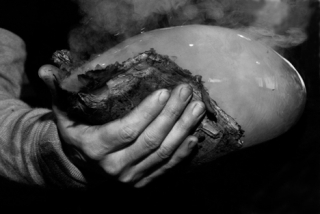Those two intricate, prehensile, multi-fingered body parts are extremely useful.
Give yourself a hand if you guessed correctly.
Hands are useful tools when greeting someone with a shake, putting food into one’s mouth, when communicating passionately or in showing solidarity when placed gently on top of a friend’s shoulder.
In fact, human hands are teeming with talent, adept as they are at both wielding a club or in the delicate task of placing thread through the eye of a needle.
Compared to other body parts, those five-fingered entities are — hands down — the worker bees of the human body.
Author Iris Graville and photographer Summer Moon Scriver have created a homage to some hard-working and talented hands of the Puget Sound region.
Graville will read and show images from their book, “Hands at Work: Portraits and Profiles of People Who Work with Their Hands,” at the Whidbey Institute at 7 p.m. Thursday, Jan. 29 in Thomas Berry Hall.
The 144-page hardcover book was released in November by Heron Moon Press and offers
23 full-length profiles and collages of people passionate about working with their hands.
The meaning of work is explored in-depth in vivid interviews with such subjects as a boat builder, a potter, a painter, a reef net fisherman, a quilter, a physical therapist, a blacksmith and others who use their hands to support themselves.
Most of those interviewed live and work in Puget Sound, and many are from Lopez Island, the home of Graville and Scriver.
“These people use the vocabulary of the spirit,” Graville said.
“They are not only willing to labor with their hands, they are nourished by that act.”
Scriver’s photographs and Seattle book designer Bob Lanphear’s layouts are a powerful combination.
“I feel fortunate to tell visual stories. In close-up portraits, the magic of black-and-white photography provides both richness and simplicity,” Scriver said.
Many of the 126 black-and-white art images are printed large and viewed in such deft detail that they take on a sensual elegance, such as in an oboe player’s thumb and forefinger that steady his instrument, or a midwife’s hand that clasps the palm of a laboring mother.
Like the photographer, author Graville also zooms in, allowing individuals to speak with candor, creating a collection of inspiring, down-to-earth stories.
Graville’s interviews, essays and memoir pieces have been published in national and regional journals and magazines.
The serendipitous meeting of the two was a match made in book heaven after Graville saw an exhibit of Scriver’s photos at an art show.
“Her prints of muscled, weathered, skilled hands engaged in knitting, kneading dough, digging potatoes and spinning wool suggested to me a passion for the kinds of work that have become rare for many Americans,” Graville said.
“These people were not only willing to labor with their hands, they were nourished by those acts. As I viewed the images, I wanted to know the stories behind them and to give voice to them. When
I approached Summer about collaborating on a collection of portraits and profiles, she agreed enthusiastically.”
So began the project which became a labor of love for the two artists, one’s hand scribbling with pen on paper, the other’s fingers click, clicking away on her Nikon D200.
The team set about listing a cross section of people who rely on their hands for their work in the small, rural community of the island.
“Whenever we made the first call to ask people to participate, most were humble, doubting that their work, their stories and their hands could be of any interest or importance,” Graville said.
Schedules were set with times for interviews and photo sessions.
“As Summer set up equipment, I explained that our goal was to engage in this process of documenting their work like ballroom dancers, leading and following as gracefully as possible. At times, I helped Summer with photographing by moving lights or suggesting shots to illustrate the subjects’ words about their work. Often, Summer added her own questions to the interview as she viewed the work through her camera lens.”
The process was often fun, such as the day they met Irene Skyriver in her garden.
“I’ve always thought of my hands as rototillers in the dirt,” Skyriver told Graville as she was scooping out a shallow hole for the corn seedling she was planting.
Scriver squatted beside her and zoomed in on the gardener’s calloused hands.
“What do you like most about gardening?” Graville asked her.
“I love moving my body — the stretch to pick a berry or an apple is like natural yoga. If you’re aware, you notice when you need to move another direction,” she answered.
“As we talked with and photographed people at work, their fervor for painting, weaving, fishing, cooking, quilting, sculpting, boat-building, puppeteering, and even car repair was palpable and exhilarating,” Graville said.
The artists were impressed with their subjects’ gratitude for being watched, for having someone listen to their stories.
“We recognized how rare it is for any of us to spend that much time talking about our work,” Graville said.
The sessions typically lasted two hours. What followed, she said, were hours and hours of mostly solitary work shaping pictures into portraits and words into stories and reviews and revisions until everyone was satisfied.
“Then we repeated the process with the next person on the list,” Graville said.
The book is available at heronmoonpress@yahoo.com or at the Web site www.handsworking.com.
For more info about the event, call the Whidbey Institute at 341-1884.


